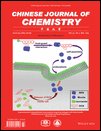Journal list menu
Export Citations
Download PDFs
Cover Picture
Cover Picture: Supramolecular Prodrug Micelles Constructed by Drug-Drug Conjugate with Water Soluble Pillar[6]arene for Controllable and Rapid Drug Release (Chin. J. Chem. 3/2015)
- Page: 301
- First Published: 16 March 2015
![Cover Picture: Supramolecular Prodrug Micelles Constructed by Drug-Drug Conjugate with Water Soluble Pillar[6]arene for Controllable and Rapid Drug Release (Chin. J. Chem. 3/2015)](/cms/asset/073e377b-6c76-4bc0-a0c4-729df37ebc47/mcontent.jpg)
The cover picture shows the construction of novel supramolecular prodrug micelles based on the host-guest interaction of water-soluble pillar[6]arene (WP6) and doxorubicin (DOX)-based drug-drug conjugate (G). Herein, the release rate of DOX from these supramolecular micelles is approximate to 100% within 30 min at pH 5.5 by simulating the endo-lysosomal environment. Significantly, intracellular localization experiments demonstrated that these supramolecular micelles, taken up by cancer cells via endocytosis, can lead to efficient DOX accumulation in SKOV3 cancer cells, implying its promising future for cancer therapy. More details are discussed in the article by Hu et al. on page 329–334.
Editorial
Contents
Reviews
Pillar[n]arenes and Other Cavitands: Aspects of Complex Thermodynamics
- Pages: 311-318
- First Published: 03 February 2015
Pillarene-Involved Metallic Supramolecular Nanostructures
- Pages: 319-328
- First Published: 09 March 2015
Communications
Supramolecular Prodrug Micelles Constructed by Drug-Drug Conjugate with Water Soluble Pillar[6]arene for Controllable and Rapid Drug Release
- Pages: 329-334
- First Published: 09 March 2015
![Supramolecular Prodrug Micelles Constructed by Drug-Drug Conjugate with Water Soluble Pillar[6]arene for Controllable and Rapid Drug Release](/cms/asset/d1176e7d-2de1-490e-aedb-14cd415c51ac/mcontent.jpg)
The construction of novel supramolecular prodrug micelles based on the host-guest interaction of WP6 and doxorubicin (DOX)-based drug-drug conjugate (G) is reported, and the release rate of DOX from these supramolecular micelles is approximate to 100% within 30 min at pH 5.5 by simulating the endo-lysosomal environment. Significantly, intracellular localization experiments demonstrated that these supramolecular micelles, taken up by cancer cells via endocytosis, can lead to efficient DOX accumulation in SKOV3 cancer cells, implying its promising future for cancer therapy.
Complexation of Linear Aliphatic Ester, Aldehyde and Ketone Guests by Per-ethylated Pillar[5]arene
- Pages: 335-338
- First Published: 09 March 2015
![Complexation of Linear Aliphatic Ester, Aldehyde and Ketone Guests by Per-ethylated Pillar[5]arene](/cms/asset/1750badc-f111-48ab-ac82-1c60f2ab8650/mcontent.jpg)
The complexation of four neutral guest molecules containing carbon-oxygen double bonds, i.e., 1,6-diacetoxyhexane (1), dimethyl hexanedioate (2), hexanal (3), and 2-hexanone (4), by per-ethylated pillar[5]arene is reported. These guests show remarkably different binding affinities. For example, ester 1 could be fully engulfed by the host cavity to form a [2]pseudorotaxane-type inclusion complex, while for 2, no obvious host-guest interaction was observed.
Naphthalene Diimide Templated Synthesis of Pillar[6]arenes
- Pages: 339-342
- First Published: 09 March 2015
A Pillar[6]arene-[2]pseudorotaxane Based pH-Sensitive Molecular Switch
- Pages: 343-345
- First Published: 09 March 2015
![A Pillar[6]arene-[2]pseudorotaxane Based pH-Sensitive Molecular Switch](/cms/asset/4168743a-49da-413b-b5d2-de0ebe6aae06/mcontent.jpg)
A novel pH-responsive [2]pseudorotaxane based on ethylated pillar[6]arene and bis(1,2,3-triazolium)butane cation was constructed. The dethreading and rethreading could be reversibly controlled by adding base and acid, i.e., the deprotonation and reprotonation of the guest. In contrast, such responsible switching behavior does not occur for the complexation between the guest and ethylatedpillar[5]arene, since both the cationic axle and the deprotonated one can be strongly bound by ethylated pillar[5]arene. Furthermore, the bis(1,2,3-triazolium)butane⊂pillar[6]arene-[2]pseudorotaxane can also disassemble upon the addition of competitive ethylated pillar[5]arene.
Full Papers
Crystal Structure and Host-Guest Binding Ability of Three Types of Pillar[5]arenes
- Pages: 346-350
- First Published: 09 March 2015
Aggregation Control of Hemicyanine Fluorescent Dye by Using of Cucurbit[7]uril and Pillar[6]arene
- Pages: 351-355
- First Published: 09 March 2015
Four Pillar[5]arene Constitutional Isomers: Synthesis, Crystal Structures, and Host-Guest Complexation of Their Derivatives with Paraquat in Water
- Pages: 356-360
- First Published: 14 January 2015
Phosphorous-Based Pillar[5]arenes for Uranyl Extraction
- Pages: 361-367
- First Published: 09 March 2015
![Phosphorous-Based Pillar[5]arenes for Uranyl Extraction](/cms/asset/d9e2affc-4287-420d-8f3b-76d512a7f5a7/mcontent.jpg)
One phosphine oxide-based pillar[5]arene 1a and two novel phosphorous-based pillar[5]arenas 1b and 1c were synthesized for use as extractants in solvent extraction of UO22+. The results from host-guest interactions pertinent to the extracted complexes of 1a–1c revealed a significant difference in complexation capability between 1a and 1b (or 1c) by using 1H NMR, 31P NMR and FT-IR techniques. The extraction of UO22+ in separate extraction system and in simulated nuclear industry effluent containing 12 competing ions demonstrated the superior efficiency and selectivity of 1a towards UO22+ over other cations in acidic feed. Log-log plot analysis indicated the 1:1 stoichiometry (ligand/metal) for the extracted complex formed between the ligand and UO22+.
Synthesis of Coumarin-Pillar[5]arene as a Selective Fluorescent Probe for Methyl-Parathion
- Pages: 368-372
- First Published: 14 January 2015
![Synthesis of Coumarin-Pillar[5]arene as a Selective Fluorescent Probe for Methyl-Parathion](/cms/asset/246e24b2-a51d-4435-80e3-8a055c324c2c/mcontent.jpg)
A novel coumarin-pillar[5]arene derivative (P5C10) was prepared. Fluorescence spectroscopy indicates that P5C10 shows good selectivity towards methyl-parathion. A combination of NMR spectra, MALDI-TOF spectra and computational calculations reveals the formation of a host-guest complex driven by π-π stacking interactions.
Synthesis of Copillar[5]arene by Co-oligomerization of Different Monomers and Its Application to Supramolecular Polymer Gel
- Pages: 373-378
- First Published: 09 March 2015
Synthesis of Pillar[n]arene[5−n]quinines via Partial Oxidation of Pillar[5]arene
- Pages: 379-383
- First Published: 09 March 2015
Synthesis of Copillar[5]arenes and Their Host-Guest Complexation with Two Types of Guests
- Pages: 384-388
- First Published: 09 March 2015





![Pillar[n]arenes and Other Cavitands: Aspects of Complex Thermodynamics](/cms/asset/38f4c053-38c7-4a2c-a186-a64b177d1801/mcontent.jpg)

![Naphthalene Diimide Templated Synthesis of Pillar[6]arenes](/cms/asset/6591a9fd-b05b-4ee6-9e64-5818731895d8/mcontent.jpg)
![Crystal Structure and Host-Guest Binding Ability of Three Types of Pillar[5]arenes](/cms/asset/3feab05f-d938-4bcf-9848-6d1f6cd2e7a0/mcontent.jpg)
![Aggregation Control of Hemicyanine Fluorescent Dye by Using of Cucurbit[7]uril and Pillar[6]arene](/cms/asset/1a80a23f-990a-4ae3-a674-74f8b0d2d81c/mcontent.jpg)
![Four Pillar[5]arene Constitutional Isomers: Synthesis, Crystal Structures, and Host-Guest Complexation of Their Derivatives with Paraquat in Water](/cms/asset/fbc81b51-dd6e-451e-b1fd-c44b973c1867/mcontent.jpg)
![Synthesis of Copillar[5]arene by Co-oligomerization of Different Monomers and Its Application to Supramolecular Polymer Gel](/cms/asset/a1722493-680c-4b97-9c33-1cae8ce853bb/mcontent.jpg)
![Synthesis of Pillar[n]arene[5−n]quinines via Partial Oxidation of Pillar[5]arene](/cms/asset/4263b7ae-4f2a-4ed1-b0d2-ebf427edbd6c/mcontent.jpg)
![Synthesis of Copillar[5]arenes and Their Host-Guest Complexation with Two Types of Guests](/cms/asset/920b7851-ff5b-4181-b427-a1448eeaddb3/mcontent.jpg)




